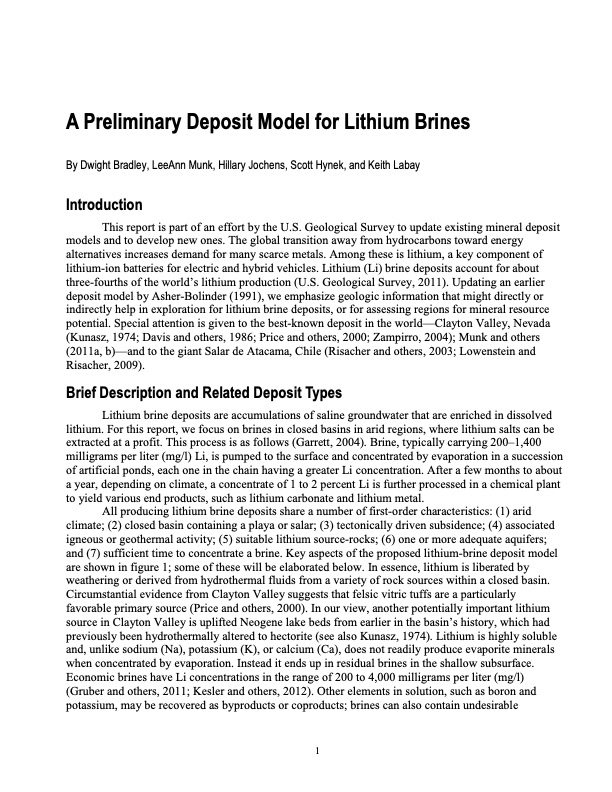
PDF Publication Title:
Text from PDF Page: 004
A Preliminary Deposit Model for Lithium Brines By Dwight Bradley, LeeAnn Munk, Hillary Jochens, Scott Hynek, and Keith Labay Introduction This report is part of an effort by the U.S. Geological Survey to update existing mineral deposit models and to develop new ones. The global transition away from hydrocarbons toward energy alternatives increases demand for many scarce metals. Among these is lithium, a key component of lithium-ion batteries for electric and hybrid vehicles. Lithium (Li) brine deposits account for about three-fourths of the world’s lithium production (U.S. Geological Survey, 2011). Updating an earlier deposit model by Asher-Bolinder (1991), we emphasize geologic information that might directly or indirectly help in exploration for lithium brine deposits, or for assessing regions for mineral resource potential. Special attention is given to the best-known deposit in the world—Clayton Valley, Nevada (Kunasz, 1974; Davis and others, 1986; Price and others, 2000; Zampirro, 2004); Munk and others (2011a, b)—and to the giant Salar de Atacama, Chile (Risacher and others, 2003; Lowenstein and Risacher, 2009). Brief Description and Related Deposit Types Lithium brine deposits are accumulations of saline groundwater that are enriched in dissolved lithium. For this report, we focus on brines in closed basins in arid regions, where lithium salts can be extracted at a profit. This process is as follows (Garrett, 2004). Brine, typically carrying 200–1,400 milligrams per liter (mg/l) Li, is pumped to the surface and concentrated by evaporation in a succession of artificial ponds, each one in the chain having a greater Li concentration. After a few months to about a year, depending on climate, a concentrate of 1 to 2 percent Li is further processed in a chemical plant to yield various end products, such as lithium carbonate and lithium metal. All producing lithium brine deposits share a number of first-order characteristics: (1) arid climate; (2) closed basin containing a playa or salar; (3) tectonically driven subsidence; (4) associated igneous or geothermal activity; (5) suitable lithium source-rocks; (6) one or more adequate aquifers; and (7) sufficient time to concentrate a brine. Key aspects of the proposed lithium-brine deposit model are shown in figure 1; some of these will be elaborated below. In essence, lithium is liberated by weathering or derived from hydrothermal fluids from a variety of rock sources within a closed basin. Circumstantial evidence from Clayton Valley suggests that felsic vitric tuffs are a particularly favorable primary source (Price and others, 2000). In our view, another potentially important lithium source in Clayton Valley is uplifted Neogene lake beds from earlier in the basin’s history, which had previously been hydrothermally altered to hectorite (see also Kunasz, 1974). Lithium is highly soluble and, unlike sodium (Na), potassium (K), or calcium (Ca), does not readily produce evaporite minerals when concentrated by evaporation. Instead it ends up in residual brines in the shallow subsurface. Economic brines have Li concentrations in the range of 200 to 4,000 milligrams per liter (mg/l) (Gruber and others, 2011; Kesler and others, 2012). Other elements in solution, such as boron and potassium, may be recovered as byproducts or coproducts; brines can also contain undesirable 1PDF Image | USGS Deposit Model for Lithium Brines

PDF Search Title:
USGS Deposit Model for Lithium BrinesOriginal File Name Searched:
OF13-1006.pdfDIY PDF Search: Google It | Yahoo | Bing
Product and Development Focus for Infinity Turbine
ORC Waste Heat Turbine and ORC System Build Plans: All turbine plans are $10,000 each. This allows you to build a system and then consider licensing for production after you have completed and tested a unit.Redox Flow Battery Technology: With the advent of the new USA tax credits for producing and selling batteries ($35/kW) we are focussing on a simple flow battery using shipping containers as the modular electrolyte storage units with tax credits up to $140,000 per system. Our main focus is on the salt battery. This battery can be used for both thermal and electrical storage applications. We call it the Cogeneration Battery or Cogen Battery. One project is converting salt (brine) based water conditioners to simultaneously produce power. In addition, there are many opportunities to extract Lithium from brine (salt lakes, groundwater, and producer water).Salt water or brine are huge sources for lithium. Most of the worlds lithium is acquired from a brine source. It's even in seawater in a low concentration. Brine is also a byproduct of huge powerplants, which can now use that as an electrolyte and a huge flow battery (which allows storage at the source).We welcome any business and equipment inquiries, as well as licensing our turbines for manufacturing.| CONTACT TEL: 608-238-6001 Email: greg@infinityturbine.com | RSS | AMP |